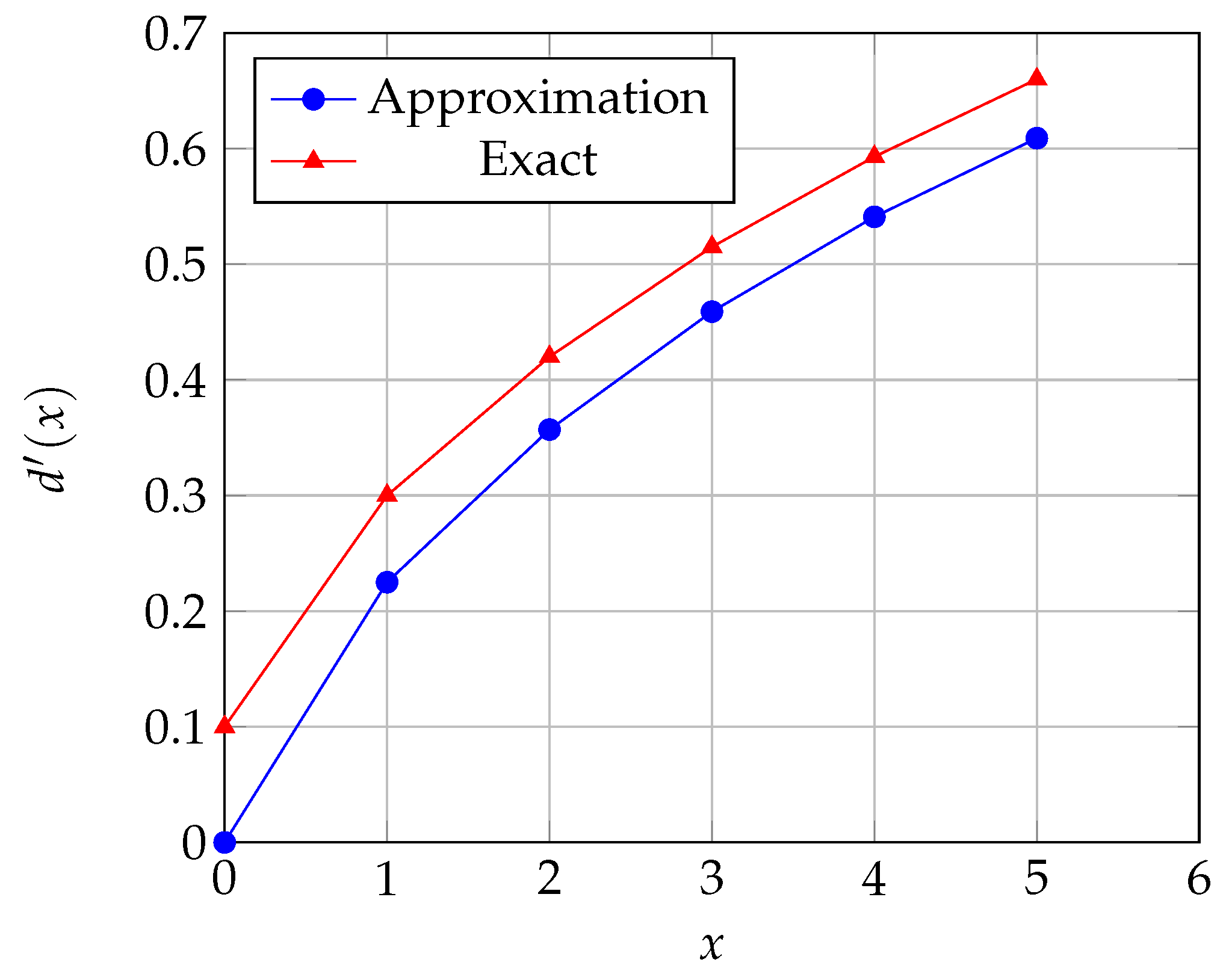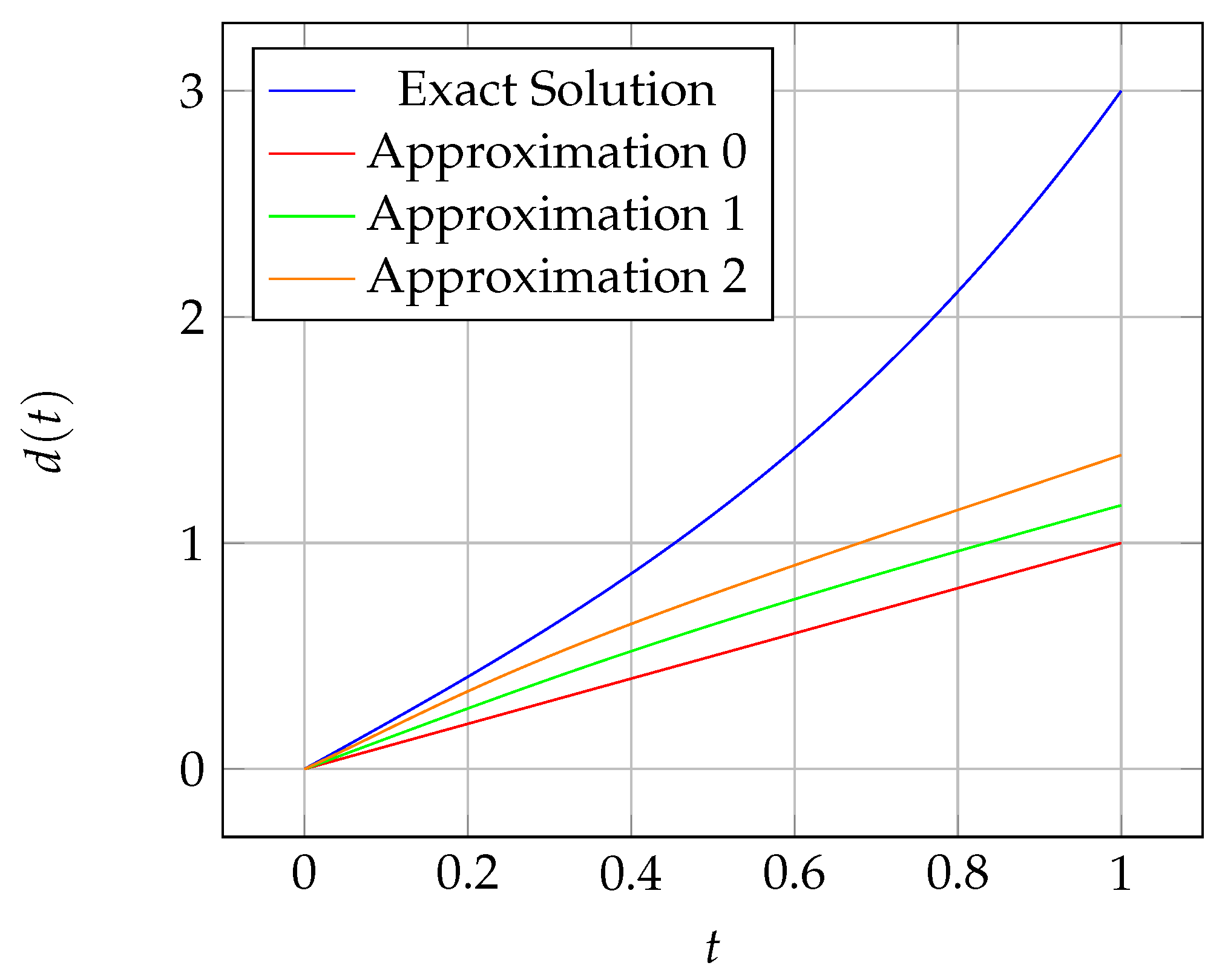Iterative Stability Analysis for Generalized α-Nonexpensive Mappings with Fixed Points
Abstract
:1. Introduction
2. Preliminaries
- 1.
- NonExp if , for all ;
- 2.
- endowed with condition (C) if for all with.
- 1.
- at the point j of asymptotic radius of bounded sequence by
- 2.
- the connection of with asymptotic radius of bounded sequence by
- 3.
- the connection of asymptotic center of bounded sequence with by
- 1.
- If Ω satisfies condition (C), it is considered a GNZ-α-NonExp mapping.
- 2.
- If Ω is a GNZ-α-NonExp mapping with a nonempty FP, then for any and as the FP of Ω, .
- 3.
- When Ω is a GNZ-α-NonExp mapping, the set is closed. Additionally, if the fundamental space is strictly convex and is convex, then is convex.
- 4.
- For all , if Ω is a GNZ-α-NonExp mapping, the inequality holds:
- 5.
- If the fundamental space satisfies the OpCd, then Ω is a GNZ-α-NonExp mapping. Moreover, if weakly converges to and , then .
3. Generalized Iterative Scheme for -NonExp Mappings
4. Application to Nonlinear Integral Equation
- 1.
- There exists a continuous mapping such thatfor all and .
- 2.
- There exists such that
5. Experimental Results
6. Conclusions
- (i)
- We introduce a new iterative scheme, denoted as , specifically designed for GNZ--NonExp mappings. Our findings indicate that the inclusion of an additional function facilitates rapid convergence for -NonExp mappings. We establish both weak and strong convergence for the modified iterative scheme.
- (ii)
- (iii)
- We provide diverse examples to illustrate and support our findings, showcasing the efficiency of the proposed algorithm across various iterative algorithms in the existing literature. This is achieved through different parameter choices and initial guesses.
- (iv)
- Consequently, our results extend the core findings of Ahmad et al. [2], serving as generalizations and refinements of the outcomes presented by Ali and Ali [14] and Ahmad et al. [2]. We extend our results from contraction to NonExp mappings and GNZ--NonExp mappings, emphasizing enhanced convergence speed.
- (v)
- To demonstrate the practical applicability of our results, we apply our findings to ascertain solutions for nonlinear integral equations.
Author Contributions
Funding
Informed Consent Statement
Data Availability Statement
Acknowledgments
Conflicts of Interest
References
- Banach, S. Sur les operations dans les ensembles abstraits et leur application aux equations integrals. Fund. Math. 1922, 3, 133–181. [Google Scholar] [CrossRef]
- Ahmad, J.; Ullah, K.; Arshad, M.; de la Sen, M. Iterative approximation of fixed points by using F iteration Process in Banach spaces. J. Funct. Spaces 2021, 2021, 6994660. [Google Scholar] [CrossRef]
- Mann, W.R. Value methods in iteration. Proc. Am. Math. Soc. 1953, 4, 506–510. [Google Scholar] [CrossRef]
- Ishikawa, S. Points by a new iteration method. Proc. Am. Math. Soc. 1974, 4, 147–150. [Google Scholar] [CrossRef]
- Noor, M.A. New approximation schemes for genreral variational inequalities. J. Math. Anal. Appl. 2000, 251, 217–229. [Google Scholar] [CrossRef]
- Agarwal, R.P.; O’Regan, D.; Sahu, D.R. Fixed Point Theory for Lipschitzian-Type Mappings with Applications; Springer: New York, NY, USA, 2009. [Google Scholar]
- Abbas, M.; Nazir, T. A new faster iteration process applied to constrained minimization and feasibility problems. Mat. Vesnik 2014, 66, 223–234. [Google Scholar]
- Khan, S.H. A Picard-Mann hybrid iterative process. Fixed Point Theory Appl. 2013, 2013, 69. [Google Scholar] [CrossRef]
- Ullah, K.; Arshad, M. Numerical reckoning fixed points for Suzuki’s generalized non expansive mappings via new iteration process. Filomat 2018, 32, 187–196. [Google Scholar] [CrossRef]
- Suzuki, T. Fixed point theorems and convergence theorems for some generalized nonexpensive mappings. J. Math. Anal. Appl. 2008, 340, 1088–1095. [Google Scholar] [CrossRef]
- Browder, F.E. Non expansive nonlinear operators in a Banach space. Proc. Natl. Acad. Sci. USA 1965, 54, 1041–1044. [Google Scholar] [CrossRef] [PubMed]
- Kirk, W.A. A fixed point theorem for mappings which do not increase distances. Am. Math. Mon. 1965, 72, 1004–1006. [Google Scholar] [CrossRef]
- Ullah, K.; Ayaz, F.; Ahmed, J. Some convergence results of M iterative process in Banach spaces. Asian-Eur. J. Math. 2021, 41, 2150017. [Google Scholar] [CrossRef]
- Ali, F.; Ali, J. A new iterative scheme to approximating fixed points and the solution of a delay differential equation. J. Nonlinear Convex Anal. 2020, 21, 2151–2163. [Google Scholar]
- Opial, Z. Weak convergence of the sequence of successive approximation for non expansive mappings. Bull. Aust. Math. Soc. 1967, 73, 591–598. [Google Scholar] [CrossRef]
- Agarwal, R.P.; O’Regan, D.; Sahu, D.R. Iterative construction of fixed points of nearly asymtotically non-expensive mappings. J. Nonlinear Convex Anal. 2007, 8, 61–79. [Google Scholar]
- Paint, R.; Shukla, R. Approximating fixed points of generalized α-non expansive mappings in Banach spaces. Numer. Funct. Anal. Optim. 2017, 38, 248–266. [Google Scholar] [CrossRef]
- Schu, J. Weak and strong convergence to fixed points of asymptotically non expansive mappings. Bull. Aust. Math. Soc. 1991, 43, 153–159. [Google Scholar] [CrossRef]



| N | F [2] | M [9] | S [6] | Picard-S [8] | Ishikawa [4] | Mann [3] | |
|---|---|---|---|---|---|---|---|
| 1 | 7.9 | 7.9 | 7.9 | 7.9 | 7.9 | 7.9 | 7.9 |
| 2 | 7.042188 | 7.06468750 | 7.12937500 | 7.3256875 | 7.1628437 | 7.3931875 | 7.51750000 |
| 3 | 7.001978 | 7.00464941 | 7.01859766 | 7.11785816 | 7.02946454 | 7.17177379 | 7.29756250 |
| 4 | 7.000093 | 7.00033418 | 7.00267341 | 7.04264992 | 7.00533124 | 7.07504367 | 7.17109844 |
| 5 | 7.000004 | 7.00002402 | 7.00038430 | 7.01543394 | 7.00096462 | 7.03278471 | 7.09838160 |
| 6 | 7 | 7.00000173 | 7.00005524 | 7.00558516 | 7.00017454 | 7.01432282 | 7.05656942 |
| 7 | 7 | 7.00000012 | 7.00000794 | 7.00202113 | 7.00003158 | 7.00625728 | 7.0325 2742 |
| 8 | 7 | 7.00000001 | 7.00000114 | 7.0007314 | 7.00000571 | 7.00273365 | 7.01870 326 |
| 9 | 7 | 7 | 7.00000016 | 7.00026467 | 7.00000103 | 7.00119426 | 7.0107543 8 |
| 10 | 7 | 7 | 7.00000002 | 7.00009578 | 7.00000019 | 7.00052174 | 7.00618377 |
| 11 | 7 | 7 | 7 | 7.00000003 | 7.00003466 | 7.00022794 | 7.00355567 |
| 12 | 7 | 7 | 7 | 7.00001254 | 7.00000001 | 7.00009959 | 7.00204451 |
| 13 | 7 | 7 | 7 | 7.00000454 | 7 | 7.00004350 | 7.00117559 |
| 14 | 7 | 7 | 7 | 7.00000164 | 7 | 7.00001901 | 7.00067597 |
| 15 | 7 | 7 | 7 | 7.00000059 | 7 | 7.00000830 | 7.00038868 |
| 16 | 7 | 7 | 7 | 7.00000022 | 7 | 7.00000363 | 7.00022349 |
| 17 | 7 | 7 | 7 | 7.00000008 | 7 | 7.00000158 | 7.00012851 |
| 18 | 7 | 7 | 7 | 7.00000003 | 7 | 7.00000069 | 7.00007389 |
| 19 | 7 | 7 | 7 | 7.00000001 | 7 | 7.00000030 | 7.00004249 |
| 20 | 7 | 7 | 7 | 7 | 7 | 7.00000013 | 7.00002443 |
| 21 | 7 | 7 | 7 | 7 | 7 | 7.00000006 | 7.00001405 |
| 22 | 7 | 7 | 7 | 7 | 7 | 7.00000003 | 7.00000808 |
| 23 | 7 | 7 | 7 | 7 | 7 | 7.00000001 | 7.00000464 |
| 24 | 7 | 7 | 7 | 7 | 7 | 7 | 7.00000260 |
| N | F [2] | Picard [1] | Mann [3] | Ishikawa [4] | M [9] | Noor [5] | |
|---|---|---|---|---|---|---|---|
| 1 | 6.9 | 6.9 | 6.9 | 6.9 | 6.9 | 6.9 | 6.9 |
| 2 | 6.04921875 | 6.0984387 | 6.45 | 6.7875 | 6.773438 | 6.172266 | 6.77168 |
| 3 | 6.002692 | 6.010767 | 6.225 | 6.689063 | 6.664673 | 6.032973 | 6.661655 |
| 4 | 6.000147 | 6.001178 | 6.1125 | 6.60293 | 6.571203 | 6.006311 | 6.567318 |
| 5 | 6.000008 | 6.000129 | 6.05625 | 6.527563 | 6.490878 | 6.001208 | 6.48643 |
| 6 | 6 | 6.000014 | 6.028125 | 6.461618 | 6.421848 | 6.000231 | 6.417076 |
| 7 | 6 | 6.000002 | 6.014063 | 6.403916 | 6.362526 | 6.000044 | 6.35761 |
| 8 | 6 | 6 | 6.007031 | 6.353426 | 6.311546 | 6.0000088 | 6.306623 |
| 9 | 6 | 6 | 6.003516 | 6.309248 | 6.267734 | 6.000002 | 6.262905 |
| 10 | 6 | 6 | 6.001758 | 6.270592 | 6.230084 | 6 | 6.225421 |
| 11 | 6 | 6 | 6.000879 | 6.236768 | 6.197729 | 6 | 6.193281 |
| 12 | 6 | 6 | 6.000439 | 6.207172 | 6.169923 | 6 | 6.165723 |
| 13 | 6 | 6 | 6.00022 | 6.181276 | 6.146028 | 6 | 6.142094 |
| 14 | 6 | 6 | 6.00011 | 6.158616 | 6.125493 | 6 | 6.121835 |
| 15 | 6 | 6 | 6.000055 | 6.138789 | 6.107845 | 6 | 6.104464 |
| 16 | 6 | 6 | 6.000027 | 6.12144 | 6.092679 | 6 | 6.08957 |
| 17 | 6 | 6 | 6.000014 | 6.10626 | 6.079646 | 6 | 6.076799 |
| 18 | 6 | 6 | 6.000007 | 6.092978 | 6.068446 | 6 | 6.065849 |
| 19 | 6 | 6 | 6.000003 | 6.081356 | 6.058821 | 6 | 6.05646 |
| 20 | 6 | 6 | 6.000002 | 6.0711867 | 6.050549 | 6 | 6.04841 |
| 21 | 6 | 6 | 6.000001 | 6.062288 | 6.043441 | 6 | 6.041508 |
| 22 | 6 | 6 | 6 | 6.0545027 | 6.037332 | 6 | 6.03559 |
| 23 | 6 | 6 | 6 | 6.047689 | 6.027571 | 6 | 6.030516 |
| 24 | 6 | 6 | 6 | 6.041728 | 6.023693 | 6 | 6.026165 |
| Iteration | Approximation | Exact | Error |
|---|---|---|---|
| 0 | 0.000 | 0.100 | - |
| 1 | 0.225 | 0.300 | 0.075 |
| 2 | 0.357 | 0.420 | 0.063 |
| 3 | 0.459 | 0.515 | 0.056 |
| 4 | 0.541 | 0.593 | 0.052 |
| 5 | 0.609 | 0.660 | 0.051 |
| Iteration | Approximation | Exact | Error |
|---|---|---|---|
| 0 | |||
| 1 | |||
| 2 | |||
| … | … | … | … |
Disclaimer/Publisher’s Note: The statements, opinions and data contained in all publications are solely those of the individual author(s) and contributor(s) and not of MDPI and/or the editor(s). MDPI and/or the editor(s) disclaim responsibility for any injury to people or property resulting from any ideas, methods, instructions or products referred to in the content. |
© 2024 by the authors. Licensee MDPI, Basel, Switzerland. This article is an open access article distributed under the terms and conditions of the Creative Commons Attribution (CC BY) license (https://creativecommons.org/licenses/by/4.0/).
Share and Cite
Iqbal, M.; Ali, A.; Sulami, H.A.; Hussain, A. Iterative Stability Analysis for Generalized α-Nonexpensive Mappings with Fixed Points. Axioms 2024, 13, 156. https://doi.org/10.3390/axioms13030156
Iqbal M, Ali A, Sulami HA, Hussain A. Iterative Stability Analysis for Generalized α-Nonexpensive Mappings with Fixed Points. Axioms. 2024; 13(3):156. https://doi.org/10.3390/axioms13030156
Chicago/Turabian StyleIqbal, Maryam, Amjad Ali, Hamid Al Sulami, and Aftab Hussain. 2024. "Iterative Stability Analysis for Generalized α-Nonexpensive Mappings with Fixed Points" Axioms 13, no. 3: 156. https://doi.org/10.3390/axioms13030156





